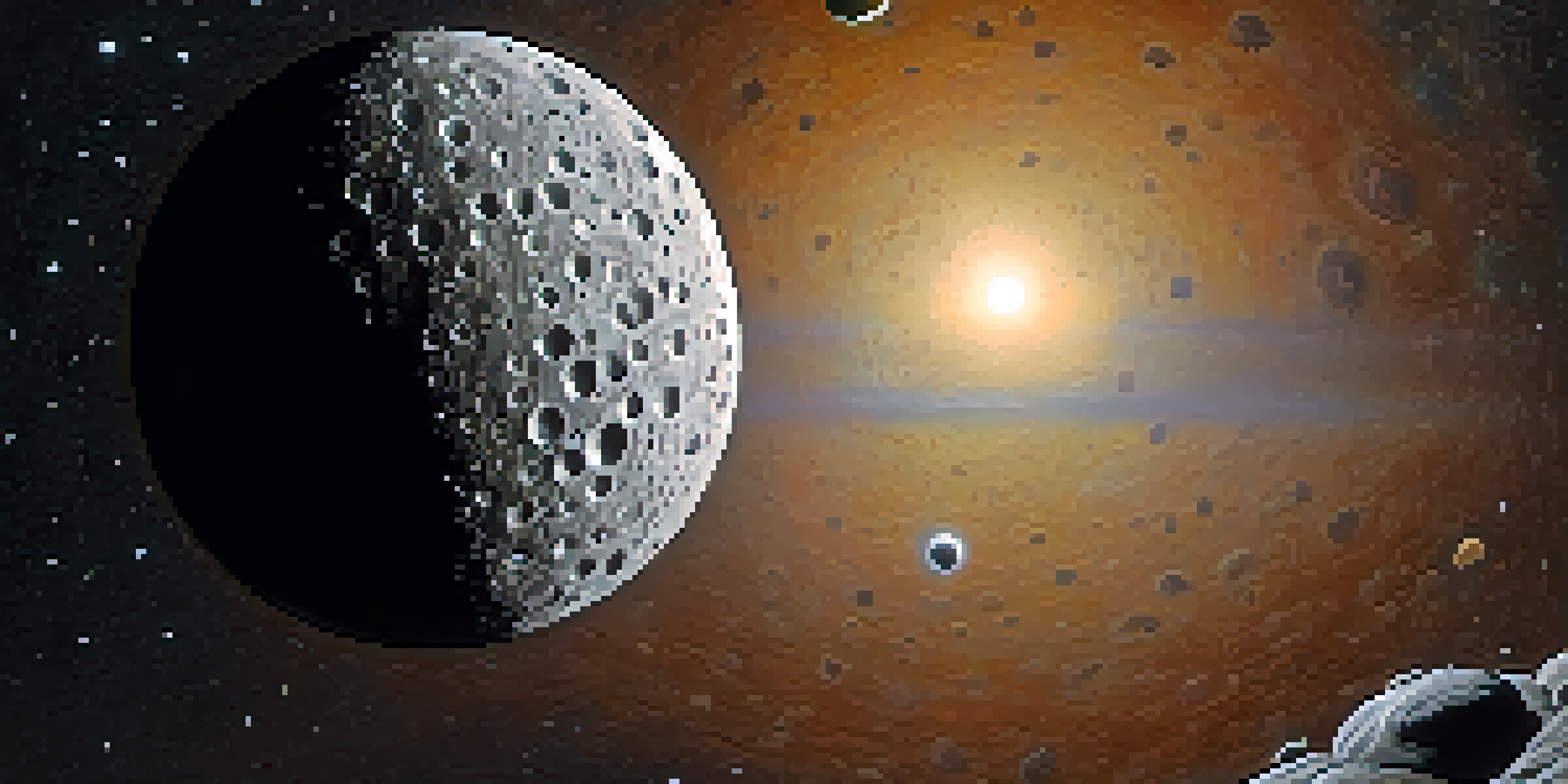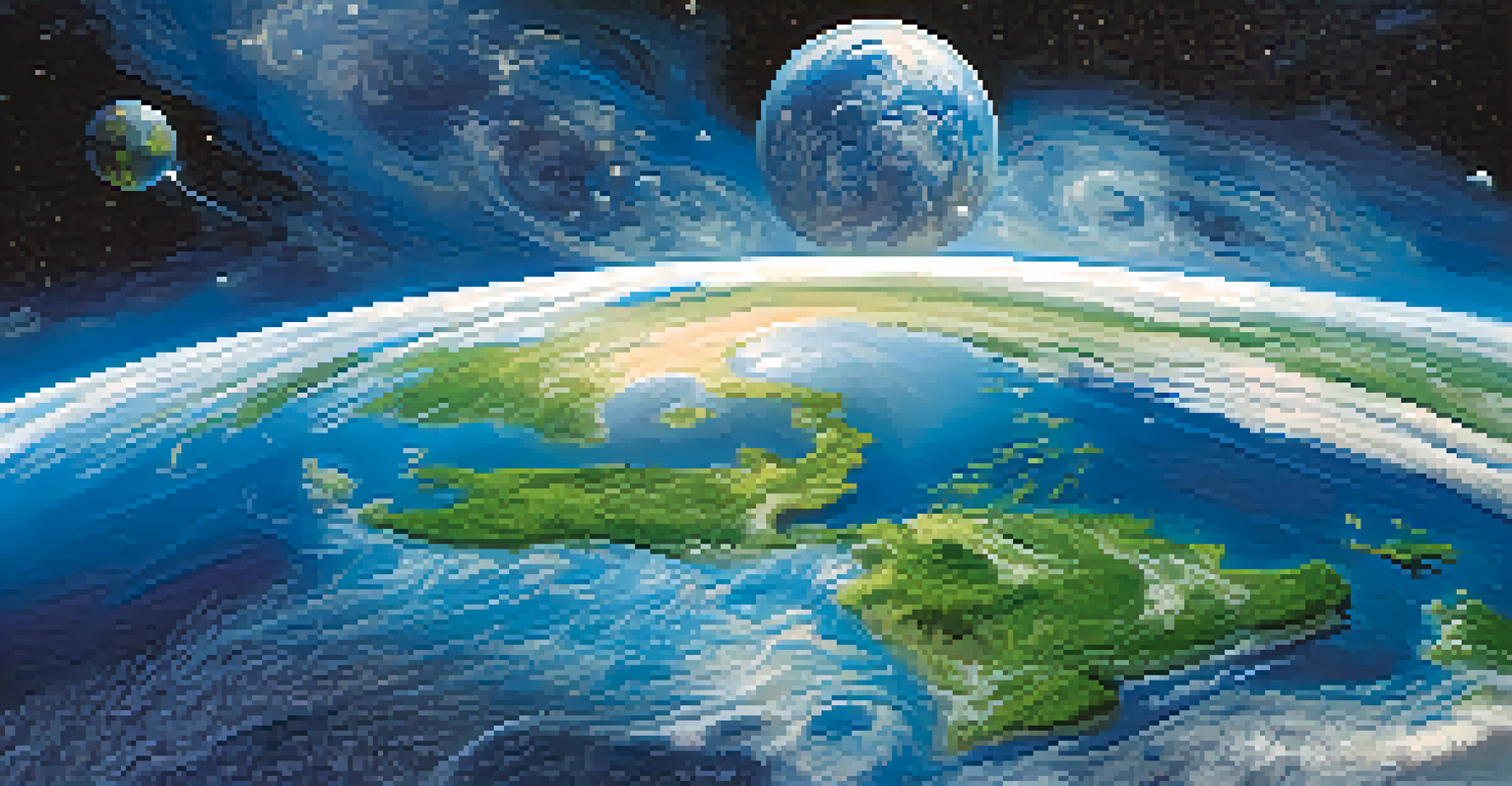The Fascinating World of Planets in Our Solar System

An Overview of Our Solar System's Planets
The solar system is home to eight unique planets, each with its own charm and characteristics. From the scorching heat of Mercury to the icy expanses of Neptune, these celestial bodies offer a glimpse into the diversity of our universe. Understanding the basic structure of our solar system is essential for appreciating how these planets interact and evolve over time.
The cosmos is within us. We are made of star-stuff. We are a way for the universe to know itself.
In addition to the eight planets, our solar system also includes dwarf planets like Pluto, moons, asteroids, and comets. This variety creates a complex and fascinating cosmic neighborhood. Each planet varies in size, composition, and distance from the sun, contributing to the rich tapestry of our solar system.
As we delve into the specifics of each planet, it's important to keep in mind that they all play a role in the grand story of our solar system. Their differences not only highlight their individual identities but also how they coexist in this vast expanse.
Mercury: The Swiftest Planet
Mercury, the closest planet to the sun, is known for its rapid orbit, completing a full revolution every 88 Earth days. This speed has earned it the nickname 'the messenger' in Roman mythology, reflecting its swift movement. Despite its proximity to the sun, Mercury experiences extreme temperature fluctuations due to its thin atmosphere.

Surface temperatures can soar to about 800 degrees Fahrenheit during the day and plunge to -330 degrees Fahrenheit at night. This harsh environment makes it a challenging place for any form of life, but it provides scientists with valuable insights into planetary formation and evolution. Exploring Mercury helps us understand the dynamics of rocky planets.
Our Solar System's Diverse Planets
The eight planets, along with dwarf planets and other celestial bodies, showcase a remarkable variety in size, composition, and environmental conditions.
Interestingly, Mercury also has a magnetic field, which is quite unusual for a planet of its size. This magnetic field raises intriguing questions about the planet's internal structure and history, making it a subject of ongoing research.
Venus: Earth's Twin with a Twist
Often called Earth's twin due to its similar size and composition, Venus is a planet shrouded in mystery and thick clouds. However, the similarities end there; Venus has a scorching surface temperature averaging around 900 degrees Fahrenheit, making it the hottest planet in our solar system. This intense heat is primarily due to a runaway greenhouse effect.
Somewhere, something incredible is waiting to be known.
The atmosphere of Venus is nearly 95% carbon dioxide, creating a thick blanket that traps heat. This hostile environment poses significant challenges for exploration, yet it also offers an opportunity to study climate phenomena that might be relevant to Earth. Understanding Venus can help us better comprehend our own planet's climate system.
Moreover, Venus has fascinating geological features, including vast volcanic plains and intriguing mountain ranges. These elements make it an exciting subject for scientists looking to piece together the planet's geological history and potential for past habitability.
Earth: Our Home in the Cosmos
Earth is often considered a unique gem in the solar system, primarily because of its ability to support life. With a perfect balance of water, atmosphere, and temperature, Earth provides a nurturing environment for countless species. Its diverse ecosystems range from lush rainforests to arid deserts, showcasing the planet's rich biodiversity.
What sets Earth apart is its dynamic atmosphere, which plays a crucial role in regulating temperature and supporting life. The presence of liquid water is vital, as it facilitates various biological processes. Furthermore, the Earth’s magnetic field protects us from harmful solar radiation, creating a safe haven for life.
Mercury and Venus: Extreme Environments
Mercury's extreme temperature fluctuations and Venus's scorching surface illustrate the harsh conditions that some planets endure.
As we explore our planet, it's essential to consider the impact of human activity on its ecosystems. Understanding how we can protect and preserve our home is vital for future generations, reminding us of our responsibility as stewards of Earth.
Mars: The Red Planet's Mysteries
Mars, known as the Red Planet due to its iron oxide-rich surface, has captivated human imagination for centuries. With its striking red hue, Mars stands out among its celestial neighbors, and its intriguing features include the largest volcano and canyon in the solar system. These geological wonders hint at a once-active planet with a rich history.
What makes Mars particularly interesting is the evidence suggesting it once had liquid water on its surface. This discovery raises questions about its potential for past life and the possibility of future human colonization. Missions to Mars, like the Perseverance rover, aim to uncover more about the planet's history and its suitability for human exploration.
The quest to learn more about Mars is not just about exploration; it's a journey toward understanding the potential for life beyond Earth. As scientists continue to analyze Martian soil and atmosphere, we edge closer to answering fundamental questions about our place in the universe.
Jupiter: The Giant of the Solar System
Jupiter is the largest planet in our solar system, boasting a staggering diameter of about 86,881 miles. Its immense size is complemented by its stunning features, including the iconic Great Red Spot, a colossal storm larger than Earth that has persisted for centuries. This giant planet is primarily composed of hydrogen and helium, showcasing a composition similar to that of stars.
One of Jupiter's most fascinating aspects is its extensive system of moons, with over 79 known to date. Among these, Europa stands out as a potential candidate for harboring life, thanks to its subsurface ocean. The diversity of Jupiter’s moons adds another layer of intrigue, making it a key target for exploration.
Gas Giants vs. Ice Giants
Jupiter and Saturn represent gas giants with their massive sizes and extensive moon systems, while Uranus and Neptune, the ice giants, reveal unique atmospheric characteristics and compositions.
Jupiter's powerful magnetic field and intense radiation belts present unique challenges for spacecraft, but they also offer insights into planetary dynamics. As we continue to study this gas giant, we uncover more about the forces that shape our solar system.
Saturn: The Ringed Beauty
Saturn is perhaps best known for its stunning rings, which are composed of ice and rock particles. These rings stretch out for thousands of miles, creating a breathtaking sight that captivates astronomers and enthusiasts alike. Saturn's unique beauty is not just skin-deep; it also has intriguing features beneath its mesmerizing exterior.
With a diameter of about 72,366 miles, Saturn is the second-largest planet in our solar system. Its gaseous composition, primarily hydrogen and helium, contributes to its lack of a solid surface. This makes Saturn a fascinating subject for studying gas giants and their formation processes.

Saturn is also home to a diverse array of moons, including Titan, which is larger than Mercury and boasts a dense atmosphere. As missions like Cassini have shown us, the exploration of Saturn and its moons holds the key to understanding the complexities of planetary systems.
Uranus and Neptune: The Ice Giants
Uranus and Neptune are often referred to as the ice giants, a classification that reflects their unique compositions and atmospheric conditions. Unlike the gas giants, these planets contain a higher proportion of icy materials, such as water, ammonia, and methane. This difference gives them a distinct bluish hue, which is particularly striking in Neptune.
Uranus is unique among the planets due to its extreme tilt, causing it to rotate on its side. This unusual axial tilt leads to extreme seasonal variations, with each pole experiencing 42 years of continuous sunlight followed by 42 years of darkness. Studying Uranus helps us understand the dynamics of tilted planetary systems.
Neptune, on the other hand, is known for its fierce winds and storms, with the fastest winds recorded in the solar system. Its dynamic atmosphere presents a contrast to the more stable conditions of its neighboring planets. Both Uranus and Neptune provide valuable insights into the formation and evolution of planetary systems, expanding our understanding of what lies beyond our immediate vicinity.